Hans Kammerlander
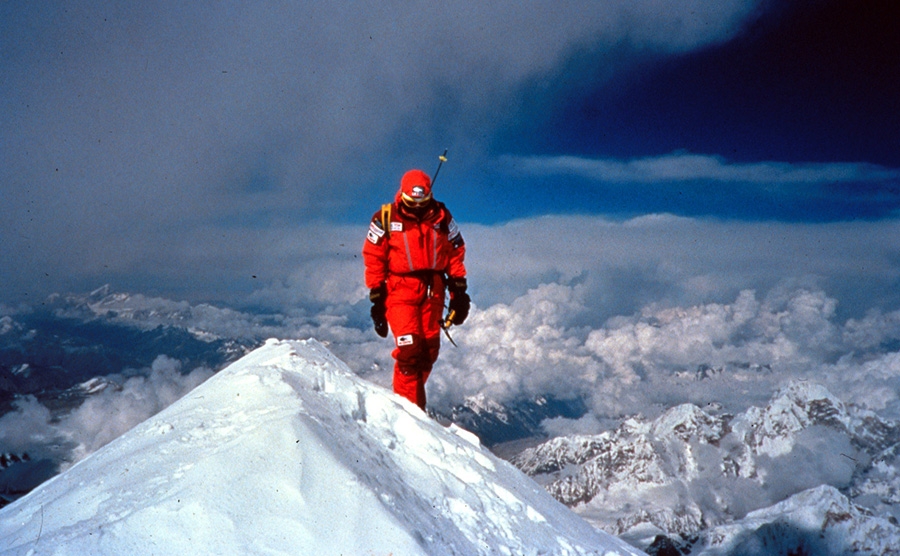
 1 / 6
1 / 6 Planetmountain.com
Planetmountain.com
He invites us to take part in what is a normal end to a day out with his climbing school. We sit down and let ourselves be taken far away for a while.
Hans is well-known for his ascents in the Himalaya and the rest of the world. He holds the record for the fastest ascent, the fastest descent and, on that occasion, the first ski descent of Everest.
That was in 1996, and Hans had an admirable mountaineering career behind him, stretching from the Alps, to Patagonia and the Himalaya where, on seven 8000m peaks, his companion was none other than Reinhold Messner.
Nothing of this transpires from his behaviour towards his group of clients. He shows a simplicity and cordiality far removed from the clichés of a super mountaineer.
This does not mean that he has abandoned his passion for major projects, or that he is cured of his "addiction" to mountains, a theme that gave rise to the homonymous title of his book "Malato di montagna".
Kammerlander is someone whose actions speak for themselves. The ascent and subsequent ski descent of K2, a project he will attempt in the near future, are testimony to this remarkable man.
In your book Malato di Montagna you talk about your passion for the mountains which began as an eight year old when you followed two tourists to the summit of the Moosstock…
Yes, I followed them because I was curious, and on the summit I felt one of the strongest emotions ever. That day was one of the most important of my life and, in a sense, the experience was a revelation.
Have you ever felt a similar emotion since then?
Yes, but a long time later on Everest in 1996. It was a dream come true, a dream that I'd been pursuing for a long, long time.
Talking about Everest, did you really want to accomplish the fastest ascent and descent?
No, it happened by chance. During the bivouac I got scared, so I left that evening and climbed throughout the night. I hadn't intended on setting a speed record, just the first ski descent.
What remains from these emotions?
It's really hard to answer a question like this because, as usual, words can't describe an emotion. It's like asking why you climb. It's a feeling inside that you just can't describe. In answer to this question a colleague of mine said it's like making love: it can't be described, it just has to be done.
Is this the famous mountain sickness, the need for adventure?
This "sickness" is also an addiction. I didn't think I was addicted to mountains, but during those last meters up on Everest I realised I was. I was exhausted but I needed it that much that I knew that if I didn't reach the top, I would have to go back there. And it's this addiction that continuously pushes you forwards.
If you climb all 14 eight thousand meter peaks, will this "addiction" remain?
What I really desire and what really attracts me right now is to ski down K2. If I manage this then I'll have achieved all I want. I'll be able to enjoy the long return back down along the path.
I immagine I'll always stay in the mountains, as a Mountain Guide and perhaps I'll climb easier mountains.
I would also like to be able to climb up the Moosstock, the mountain I first climbed as an eight year old, when I'm eighty.
Will you continue to return to this mountain?
Yes, and I always enjoy doing so. I can measure my fitness there. I know exactly how quick I am and whether I'm ready for the 8000m peaks. I like running to the summit, sitting down and remembering. I can see the long path which started when I was a child and I realise how long and difficult it was at times. But I have to say that the memories are always nice, even during the hardest and most painful moments.
K2 is your "problem". Why do you want to do it in a harder way, that is, why ski down it?
Skiing has always been my great passion. Climbing came later and immediately became extremely important. Combining these two disciplines produces a really strong emotion, and being able to do both on a mountain such as Everest, or other 8000ers such as K2, is of course an incredible dream.
I also feel that climbing via the normal route doesn't satisfy me, since the probability of reaching the top is so high that I'd miss the uncertainty. This tension which stimulates and pushes me on would be lost on a normal route.
Of late I've mostly been searching for this adventure and these emotions. So it's not so much a collection of summits, but a search for the unknown, an exploration.
Reaching the summit isn't very important. What counts more is the intensity of the experience, especially if you share it with a good partner.
So in many ways you're still that eight year old who throws away his schoolbag and follows those two tourists...
Your Himalayan experience began with Reinhold Messner with whom you climbed seven 8000m peaks. What memories do you have of this time?
Every beginning is special, and this is true of my first 8000m peak, Cho Oyu. There were so many unanswered questions such as whether I'd be able to withstand the altitude. I didn't know what to expect, so it was a great advantage to have someone as expert as him beside me, who helped me avoid the mistakes I would surely otherwise have made.
One of the things that sticks clearly in my mind is the traverse of the two Gasherbrum: a marvellous clean ascent, 8 days in pure alpine style.
It was one of my hardest ascents and this level of difficulty can be upped only through the Everest-Lhotse traverse.
Is the Everest-Lhotse traverse a dream of yours?
It would be the next step, perhaps a thing for the next generation. For me personally it wouldn't be easy because I've already climbed both Everest and Lhotse, and it would be extremely difficult to find the energy to give so much again.
You were on Lhotse together with Reinhold Messner. It was his fourteenth 8000m peak and your seventh…
Yes. The wind was brutal the morning we left camp: it pushed us upwards like a ski-lift. The risk of frostbite was very high, but we accepted it and the wind made us a lot faster.
I wanted to reach the top, I knew it was his fourteenth 8000m peak and he really wanted it too. I also knew that in all those years I had received a lot from Reinhold and that day I wanted to give all so that he could achieve his aim. I was very happy.
I also need to add that at that time I was very young and I took far more risks. I found it difficult to accept that I had to turn back.
And now?
Now it's different: turning back has become a lot easier and I'm happy about this. So last year it wasn't difficult to turn back 170m below the summit of K2 because conditions were simply too dangerous. I have to admit that I took too many risks when I was young. It was practically a challenge. The reason why I'm here today is that I've been extremely lucky. Only now do I realise how often I pushed myself beyond the limit, for example, during my "criminal" solos on friable, loose faces. At that time, however, I really needed it.
I still search for the "challenge', but I now see it with different eyes and since I have far more experience, I see it earlier and am able to avoid it.
Has your relationship with your climbing partners changed since the beginning?
I've always had an excellent relationship with my partners on the mountain. Even though I've lost touch with many and we've gone our different ways.
At one point you found yourself having to organise expeditions and plan your projects on your own.
I've always gone in search of change. When Messner stopped after his fourteenth 8000m peak I found myself with more time to dedicate to technical difficulties here in the Dolomites or Alps.
Then, all of a sudden, I awoke with the desire to go back to altitude and experience the marvellous culture of Himalayan people. I had to learn a lot of things in the beginning, but now I've got a team that helps me with the organisation and sorts out many of the logistical problems.
With all this work, is it possible to free your mind for large projects?
This year is extremely intense: I have to hold 80 slideshows; in June I want to climb a 6000m peak with my climbing school; and I would also like to climb K2.
In summer I've got some other obligations with the school, then in autumn I'm back in Nepal, then there are the sponsors to think about, a house to build… it's stressful. The last couple of years have become quite intense.
Has it become more difficult to get the right frame of mind for important projects?
Yes, it's become more difficult. That's also why I'm not going directly to K2, but first I'm going to climb a 6000m peak. The last few years have been stressful and I need to free my mind. A good recipe for success is to climb a different peak before attempting the main goal. To be stress free and to have the right frame of mind are fundamental when going into the mountains: success is 70% in the mind.
Are you able to rid yourself of pressure from your sponsors, from other mountaineers and all that's around you?
I'm lucky because I've got sponsors who don't push me into doing things I don't want. If that were the case I would annul the contract immediately. This has never happened though and I know that I'm lucky, but I'm also in a situation now in which I can say no, and this clearly is a great advantage.
Many young mountaineers however make mistakes and take risks when they shouldn't, because they feel under pressure from sponsors. I don't feel under pressure from my colleagues. On the contrary, if someone is successful I'm happy and my spontaneous reaction is to congratulate them.
When one talks about 8000m peaks, one also thinks about the "death zone"…
It's very stimulating to "live" in the death zone. Before I climbed my first 8000m peak, Cho Oyo, I thought I knew my body quite well. But when I arrived at altitude I realised that I knew absolutely nothing at all.
I experienced things I'd never felt before. To clarify this point, one should bear in mind that when I'm fit on the Moosstock I can do 1600m altitude gain in one hour and eight minutes. In one hour in the death zone I can climb 100m.
It's always exciting and motivating to climb at those heights, but only by fair means. I wouldn't feel these sensations if I climbed with supplementary oxygen, which I'm completely against.
The difference between climbing with or without oxygen is like day and night. It's like doing the Tour de France with a moped.
Is that a hallmark of your ascents?
Yes. I absolutely refuse supplementary oxygen. An 8000m peak becomes 7000 and the sporting achievement is lost completely. Not to mention the large number of oxygen bottles and other stuff left behind as rubbish.
It also needs to be said that the Sherpas are treated very badly because of the need for oxygen since they have to carry the bottles for the mountaineers.
I accept the pioneers' use of oxygen. But ever since it was shown that it can be done without, I don't accept it. If you use oxygen then perhaps you reach the summit, but I don't consider it a real ascent.
If these mountaineers brought the oxygen bottles back down with them, could you accept it?
If they were capable of bringing everything back down, perhaps I could. What really annoys me however is the misuse of the Sherpas and that rubbish is left behind on the mountain.
Fundamentally their ambitions are twisted: it would be far more intelligent to climb a 7000m peak and be able to say "I did a great ascent", instead of raping an 8000er by climbing it with supplementary oxygen.
You used the word pioneers. Is this still applicable in the Himalaya?
No, so much has already been done. Tomaz Humar, for example, made a fantastic and difficult ascent on Dhaulagiri, an example to all. He is to be congratulated, but I don't think he can be described as a pioneer.
Will you continue to work as a Mountain Guide?
It's become more a hobby than a profession, but I still very much enjoy taking people trekking or climbing. At the end of the day it's marvellous to see how the clients look at the mountains.
What do you tell these people?
I talk to them about Nepal and Tibet. I practically feel at home in Nepal: I love the people. I've built a school there to thank them for the strong emotions and to give something in return for their hospitality and friendship.
But when I go to Tibet my heart bleeds, because what the Chinese are doing to the Tibetans cannot be described.
As Hans Kammerlander, is there anything you can do?
What I can do is bring the problem to light. To inform people about it, write articles, take photos. Because people can't react if they don't know about the problem. This is the only thing I can do. My hands are tied.
How would you explain your mountaineering style to a young person?
First of all, it's extremely important to spend enough time at base camp. Not rush things, remain really calm, do nothing for five, six days, don't even try to reach camp 1. It's a lot better to read a good book. Many expeditions make the mistake of going up high immediately, perhaps to make use of a spell of good weather, but the expedition will fail because of this haste.
Afterwards however, when you do decide to go, go quickly, because speed means safety in the mountains. During the ascent speed is of essence: few bivouacs, the fewest possible, because nights are so tiring. At altitude they bring fear, and if you accumulate this negative energy you become weak.
What could you suggest to mountaineers in search of new projects?
I would suggest they concentrate their energies on traverses: there's still a lot to do in this area. For example, in Patagonia there's the Cerro Torre - Torre Standhart - Torre Egger traverse, and in the Himalaya there's Everest - Lhotse.
I think that if you want to become a professional mountaineer then you can't not consider these traverses. There are still some possibilities in this direction, still some chances.
What's your dream?
As I mentioned before, from a sporting point of view my dream is definitely to make the first ski descent of K2. I've left K2 right to the end on purpose, to relive some really strong emotions.
The Himalaya aside, do you have any other dreams?
I would like to finally build a house, to settle down a bit. My passion for the mountains has taken me all around the world, almost like a gypsy and I haven't had time or enough energy for things of this sort. Now I would like a beautiful house, with a nice cellar for wines from all over the world!
HANS KAMMERLANDER
Hans Kammerlander was born in 1956 in the South Tyrol, Italy, the last of 6 children. He began climbing at an early age, first near home, then in the Dolomites the Alps and the Himalaya. He has climbed twelve 8000m peaks, seven of which with Reinhold Messner.
Kammerlander is a UIAGM Mountain Guide and director of the climbing school ALPINSCHULE SÜDTIROL. He is a product consultant for various manufacturers, and has also appeared on numerous occasions on German, Austrian, Italian and satellite TV. He organises slideshows within Italy and Europe.
ALPS - DOLOMITES
Approx. 2000 routes, of which about 50 first ascents and 60 grade VI solos.
Eiger N Face - Matterhorn N Face - Grandes Jorasses N Face.
Tre Cime N Face - Marmolada S Face - Civetta NW Face.
1991 'Within the South Tirol': 1200 km of climbing and walking, 100,000 m altitude gain and more than 3000 peaks, together with R. Messner in 6 weeks in autumn 1991.
'From North to North': in 24 hours he climbed the N Face of the Odle and the Tre Cime (via Comici) together with H.P. Eisendle; the 246 km seperating the two mountains (from Sulden to Misurina), were covered by bicycle.
1992 '4 x Matterhorn': 4 ascents of Matterhorn in 24 hours along the Hornli, Furggen, Lion and Zmutt crests.
HIMALAYA - KARAKORUM
1983 Cho Oyu, 8202m - 1st ascent of S Face with R. Messner
1984 Gasherbrum traverse - 1st traverse of two 8000m peaks, together with R. Messner (Hidden Peak 8068m and Gasherbrum II 8035m)
1985 Dhaulagiri, 8172m - with R. Messner. Annapurna 8091m - with R. Messner - 1st ascent of NW Face
1986 Makalu, 8481m -with R. Messner and F. Mutschlechne. Lhotse 8511m - with R. Messner
1990 Nanga Parbat, 8125m - 1st ski descent
1993 Shivling (India), 6543 m - 1ascent of North Pillar - together with Christoph Hainz.
Ama Dablam, 6812m ( Expedition Alpinschule Südtirol)
1994 Broad Peak, 8048 m - ski descent from 7000m
1996 Shisha Pangma, 8012m
1996 Everest 8848m - fastest ascent and ascent/descent in in 23:50 hours (start Advanced Base Camp, 6400m - summit in 16:40 hours, return to Base Camp)
1998 Kanchenjunga 8586m - ski descent from 7500m
1999 K2 - stopped 150m short of the summit due to avalanche danger .
PATAGONIA
1988 Cerro Torre - at that point the fastest ascent/descent in 17 hours
1989 Punta Poincenot
SPONSORS
SECTOR - NO LIMITS - TELECOM - SÜDTIROL - ORTOVOX - TREZETA - LESTRA - CAMP - DUNOVA - KOMPERDELL - FUJIFILM - RAIDER.
THE BOOK
Addicted to mountains BY Hans Kammerlander
Malato di montagna
Casa Editrice Corbaccio
pag. 255
colour photographs,
retail price £ 32.000
For a signd copy http://www.kammerlander.com/buch.html
THE CLIMBING SCHOOL
Alpinschule Sudtirol
Via Jungmann, 8
I - 39032 Campo Tures
Tel. and Fax +39 474 690012
Internet: http://www.kammerlander.com
Email: info@kammerlander.com



 Copia link
Copia link

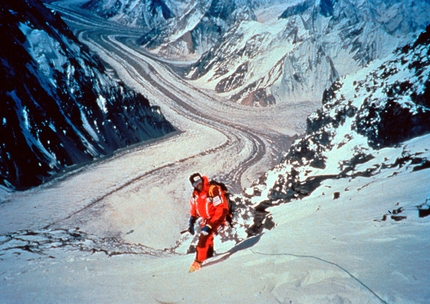
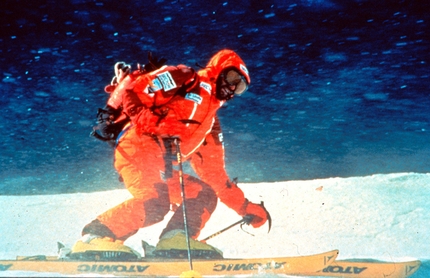
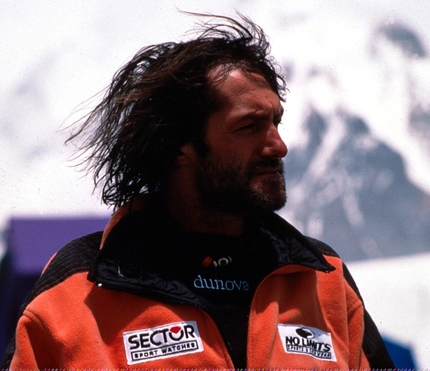
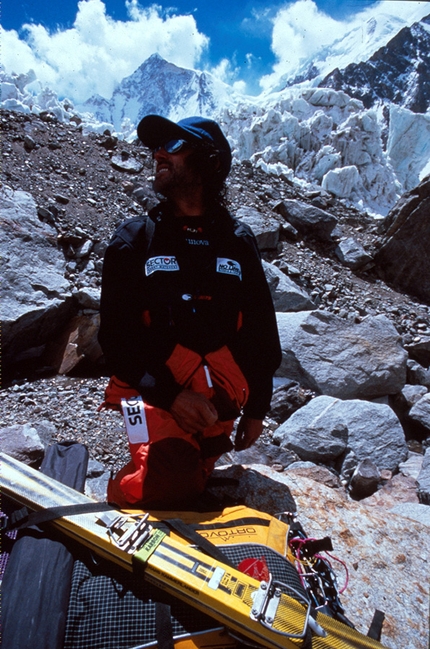
 See all photos
See all photos






















